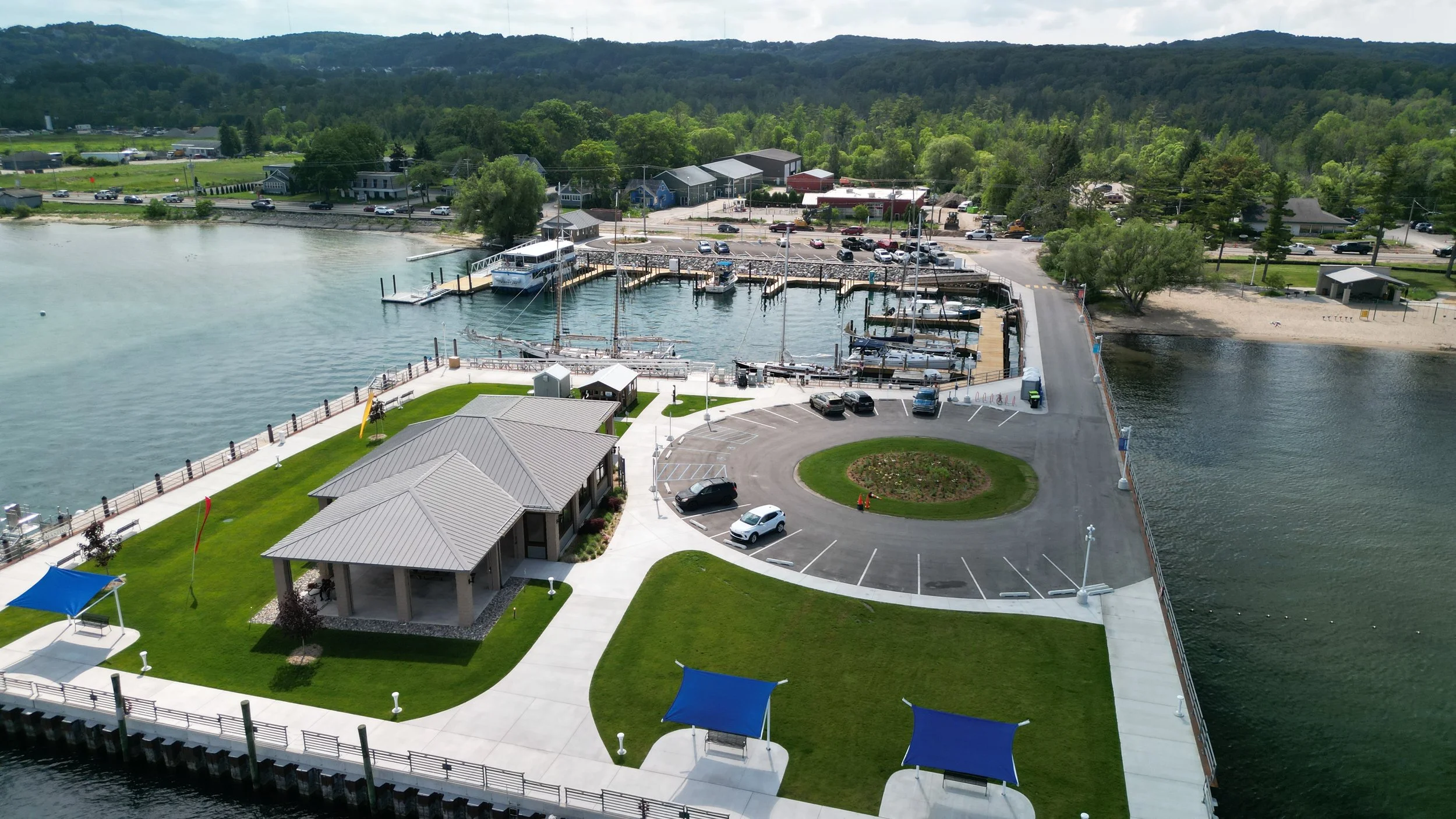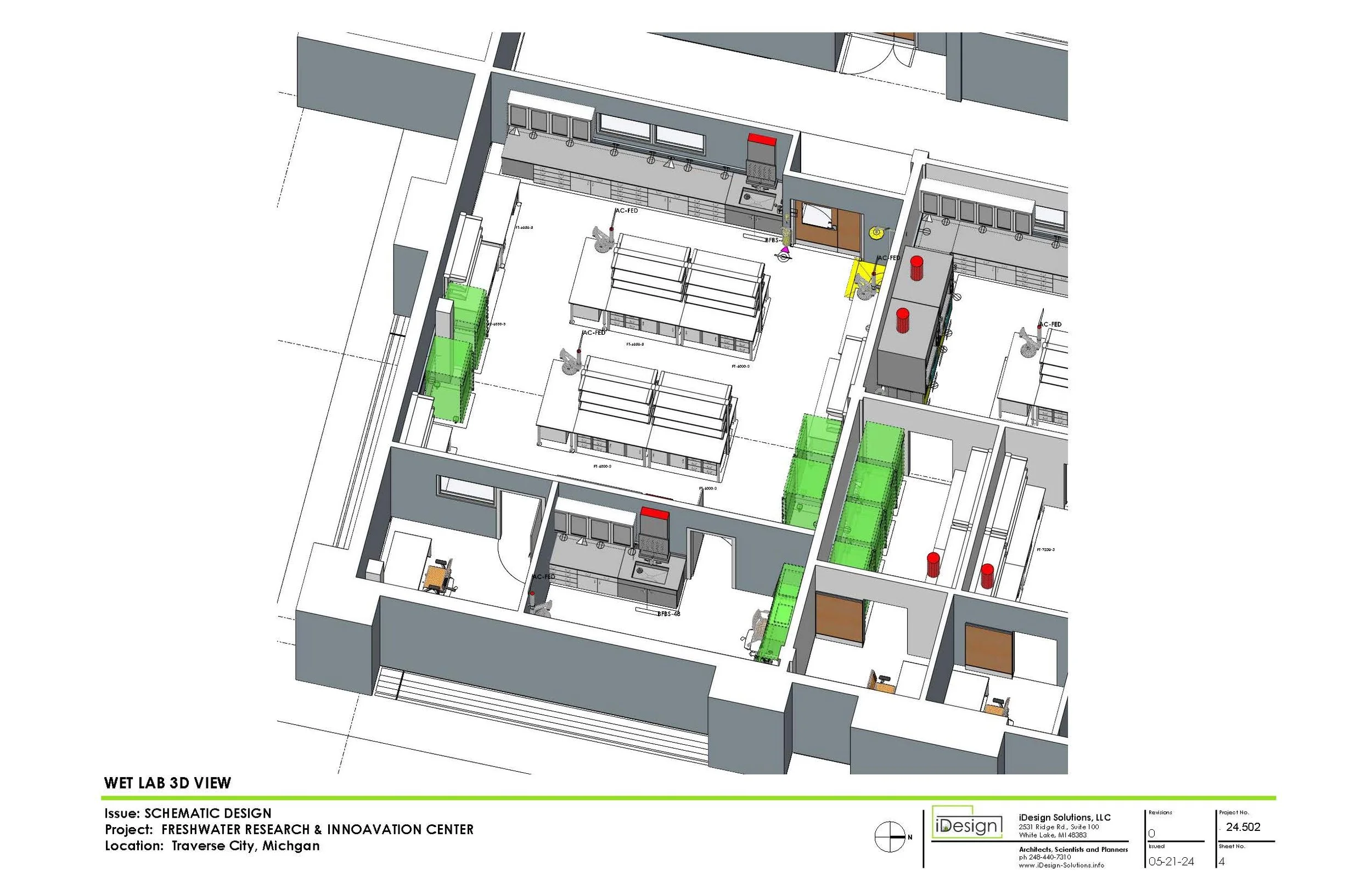Lab Hub to Drive Blue Tech Innovation on the Great Lakes
The Freshwater Research & Innovation Center in Traverse City, MI, brings together labs, incubation space, and waterfront access to support education, research, and commercialization in freshwater technology. Image: Courtesy of Cornerstone Architects
Northern Michigan is positioning itself as a global hub for water technology and marine mobility with the development of the Freshwater Research & Innovation Center (FRIC), a $28.9 million, 40,000-sf facility designed to drive the "blue economy" and establish the region as an epicenter for water innovation. After officially breaking ground on September 12, 2025, the center will serve as a collaborative platform to move ideas from lab to market while safeguarding freshwater resources.
The project team includes Cornerstone Architects and The Christman Company.
Located at 13170 S West Bay Shore Drive on Discovery Pier's campus in Traverse City, MI, the project is a joint venture between Discovery Pier and Northwestern Michigan College (NMC), with support from Traverse Connect, Michigan Technological University, and 20Fathoms. The facility's design co-locates advanced laboratories, business incubation space, and working pier access under one roof, creating a powerful accelerator for blue tech ventures. It will support education, research, innovation, incubation, and commercialization in freshwater technology.
"Blue tech" refers to technologies and innovations focused on the sustainable use, management, and protection of freshwater and marine resources, supporting both environmental stewardship and economic growth.
A flexible design for unknown tenants
FRIC’s flexible lab design supports early-stage blue tech ventures, with modular wet lab space built to accommodate a range of future tenants, despite the challenge of unknown user needs. Image: Courtesy of Cornerstone Architects
Unlike traditional academic or corporate research facilities, FRIC is designed as an "innovation facility," focused on supporting entrepreneurs in the early stages of new ventures. Its goal is to provide wet lab-type space that allows innovators to transition from ideation to prototype development and commercialization. The ecosystem is intended to foster collaboration where water education, research, and innovation translate directly into blue tech sector jobs and new businesses.
This mission posed a significant design challenge: how to create a state-of-the-art lab without knowing the exact needs of future tenants. Ed Bailey, project manager for the Freshwater Research and Innovation Center at Discovery Pier, told Lab Design News, "How do you build a facility without really knowing who your tenants are going to be? That was the single biggest challenge. Because, as you know, building lab facilities is not cheap, and it's very expensive." The team worked to "balance that future need with the cost," resulting in a $30 million facility.
To inform the design, the team studied other incubators—most notably Michigan State University's Spartan Innovations incubator—and consulted with early-stage entrepreneurs on space and equipment requirements. The final design is "as technically feasible and flexible as possible," combining robust infrastructure with modular adaptability.
The facility is organized around a 1,000-sf lab module, with seven modules on the upper level and potentially three on the lower level, allowing for easy customization. There are two primary lab types: wet labs, which support a single entity or researcher, and mini labs, which accommodate up to three entities or researchers with shared common areas. Specialty labs on the second floor provide basic equipment, including wet lab bench space, fume hoods, chemical or biological storage, and biosafety cabinets.
Shared resources include a decontamination autoclave, a glassware-washing area, and a centralized DI water system. Labs are equipped with flexible casework, emergency power, and space for user-dedicated equipment. Mini labs also offer private lab and office areas for each user.
Supporting prototype development is a high bay and makerspace, which Bailey describes as "a facility designed for prototype development." This area includes tools such as "a welder, the printers, the laser cutters, paint booths," providing flexibility for building as needed. The high bay also features an indoor water tank and a gantry crane with a 3,000-lb. capacity. Large doors and elevators ensure that "new equipment in and out" is never a logistical issue.
Leveraging the Great Lakes testbed
FRIC’s waterfront location on Grand Traverse Bay provides direct access to deep water, enabling hands-on testing and research for blue tech innovations. Image: Courtesy of Cornerstone Architects
FRIC's location on Discovery Pier, with direct access to West Grand Traverse Bay, is central to its identity as a blue tech hub. "What makes us uniquely positioned to be kind of a center of blue tech is we're sitting on Grand Traverse Bay, so we have access to deep water, and using the bay as a deep water test facility," Bailey says.
Entrepreneurs and researchers will use the facility and the Bay for projects involving autonomous vessels, sensor technologies, and other innovations addressing Great Lakes challenges. Design accommodations include a line running under the road to bring bay water into the labs, dock space for research vessels, and a three-ton crane to facilitate equipment movement. The pier also features a dockside learning lab and pavilion.
Communal spaces further support collaboration. The main lobby features an interactive public display, while second-floor spaces include research collaboration areas, a café, conference rooms, seminar/classroom spaces, shared offices, and foodservice.
Building the blue tech pipeline
FRIC’s modular lab design features wet labs, mini labs, and specialty labs with shared resources, providing flexible, fully equipped spaces for a range of research and innovation needs. Image: Courtesy of Cornerstone Architects
FRIC is more than a lab facility—it is part of an integrated regional ecosystem designed to attract national and international tenants, create high-wage jobs, and generate research with global impact. Key partners include:
Traverse Connect: Local economic development agency.
20Fathoms: Provides startup support, including financing, business development, market analysis, and IP guidance.
Northwestern Michigan College (NMC): Offers workforce development and training, including a rare bachelor of science in marine technology.
An annual binational "blue tech innovation challenge" connects innovators with resources and funding to advance freshwater-focused ideas. Participants engage in a one-year program culminating in a pitch competition for non-dilutive funding.
By co-locating education, research, and industry, FRIC provides a platform for collaboration in freshwater technology and blue tech. With more than $26 million in funding secured, the center is expected to support research, workforce development, and innovation in the Great Lakes region.




